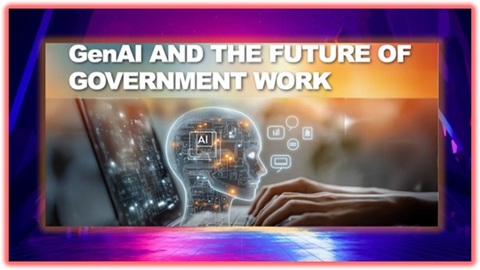The emergence of generative artificial intelligence has sparked urgent questions about the future of work, particularly within government agencies that employ millions of Americans. In my recent interview on The Business of Government Hour, Professor Bill Resh from Georgia State University's Andrew Young School of Policy Studies discusses his timely IBM Center report, "Gen AI and the Future of Government Work," (with contributors Gül Nisa Gürbüz, Yi Ming, Xinyao (Andy) Xia, Michael Overton, and Brandon De Bruhl), which offers a nuanced, data-driven analysis of how AI technologies will reshape federal employment across more than two million positions.
A Novel Methodology: Using AI to Study AI
What distinguishes Resh's research from previous workforce impact studies is its innovative methodological approach. Rather than relying on conventional workforce analysis techniques, his team employed what he describes as a "retrieval augmented generative approach" using large language models to evaluate federal occupations. As Resh explains, this system "provides a way for us to chunk these textual components of data" and "organize that data according to its semantic meaning," allowing researchers to analyze hundreds of occupations across millions of positions efficiently.
The methodology leverages GPT-4 to assess individual competencies, knowledge, skills, and abilities, which comprise each federal occupation. By breaking down jobs into granular units of analysis rather than treating positions as monolithic categories, the research provides compelling specificity. "The model scores the extent after it takes that textual data chunks it into this vector database that's easily accessible," Resh notes, enabling the system to evaluate each competency's susceptibility to AI impact and provide explanations for its assessments.
This approach yielded what Resh describes as "very high construct validity," meaning the model's reasoning aligned closely with expert judgment. The system analyzed data from authoritative sources including the Office of Personnel Management, the Bureau of Labor Statistics, and the Office of Management and Budget, grounding its predictions in established occupational frameworks while incorporating the latest scholarship on AI's labor market effects.
Beyond Replacement: A Three-Dimensional Framework
Perhaps the most significant conceptual contribution of Resh's research is its rejection of the binary "will AI replace workers or not" framing that dominates much public discourse. Instead, the study introduces a three-dimensional framework examining complementarity, augmentation, and substitution as distinct forms of AI impact.
"One dissatisfaction, relative dissatisfaction that we had" with existing literature, Resh explains, was that "there were these very kind of generic conceptualizations of impact, that it seemed to focus most heavily on the idea of replacement." This approach, he argues, puts "the cart before the horse" by assuming replacement as the primary outcome rather than carefully examining how AI might interact with different aspects of work.
- Complementarity refers to how "AI helps perform the job as it's currently defined," supporting workers in executing their existing responsibilities more efficiently.
- Augmentationrepresents "a relative change of the job," where positions evolve as people integrate "new AI enabled methods or workflows."
- Substitution, meanwhile, describes scenarios where "AI can perform the task end to end with minimal human input in the process."
The crucial insight is that "most occupations blend all three of these impacts across different competencies." A given federal position might involve some tasks that AI complements, others that it fundamentally transforms, and still others that could potentially be automated—but this complexity disappears when analysis focuses solely on whether entire jobs will be replaced.
As Resh emphasizes, "a simple replace or not replace frame really obscures where to redesign processes, where to retrain individuals who are in these occupations."
Key Findings: High Complementarity, Low Substitution
The research findings challenge apocalyptic narratives about wholesale job displacement in government. Resh's analysis reveals that "most of the federal roles score high on the complementarity and the augmentation, but low on the substitution." This pattern reflects the fundamental nature of government work, which "is people work, it is interfacing with publics, it is acting on behalf of the public, and so therefore it's hard to automate many of these functions."
White-collar positions, such as policy analysis, engineering, scientific work, and medical roles, demonstrate particularly strong complementarity and augmentation potential. These "knowledge intensive jobs" can leverage generative AI to "accelerate things like analysis," helping workers "draft memos helps you draft, you know, letters" and supporting analytical processes.
However, as Resh emphasizes, "humans still retain judgment and critical judgment where Gen AI is not positioned, I think ethically, but also just in terms of its own competence," to substitute for human decision-making.
Administrative and clerical roles present a more complex picture. Positions involving "rules based repetitive tasks," such as processing applications or performing routine functions, "face higher substitutivity because of the repetitive nature of the tasks." Yet Resh cautions against viewing these workers as simply replaceable, suggesting instead that organizations "might consider upskilling those staff into other types of roles or aspects of their current roles that are under emphasized, such as customer contact and exercising more emotional intelligence."
Tradecraft and labor positions, such as mechanics, electricians, and other hands-on roles, remain relatively resistant to substitution by generative AI specifically. Resh notes that "Gen AI tends to be integrated into a lot of those other technologies," suggesting more modest impacts through "smarter power tools" rather than worker replacement.
The Competency-Level Analysis: Knowledge, Skills, and Abilities
Drilling deeper into specific competency types reveals important nuances. Knowledge elements, particularly explicit knowledge that can be codified and shared, show "high scores across all three dimensions" of AI impact. Generative AI excels at processing and synthesizing explicit information, making it "really good at" complementing knowledge-intensive work. However, tacit knowledge, meaning the experiential understanding gained through years in an institution, remains beyond AI's reach.
As Resh illustrates through an example of organizational shorthand, when colleagues reference "the Bill Resh incident," they draw on "so many complexities that are encapsulated within that heuristic" that "you can really only get with experience in the institution."
Skills present a mixed picture. While "routine and procedural" skills may be automatable, "analytical critical thinking skills, creative skills are going to change" but remain essential. These higher-order capabilities become "much more important in delivery of outputs from these occupations" as routine tasks are automated.
Abilities, such as judgment, empathy, and leadership, prove "the most substitution resistant." These fundamentally human capacities represent areas where organizations should "double down" when considering workforce development strategies. The implication is clear: as AI handles more routine cognitive tasks, uniquely human capabilities become increasingly valuable rather than obsolete.
Practical Applications: From Theory to Implementation
The research's practical value extends beyond academic interest to actionable workforce planning. Resh and his team demonstrated this by creating visualizations, such as their heat map of the U.S. Department of Agriculture, showing "who we're in these existing occupations and where someone, the Secretary of the Department of Agriculture, or someone thinking more carefully in terms of the management side" might target training and upskilling initiatives.
By matching impact scores to actual workforce composition data from OPM's data cube, agency leaders can identify specific offices and positions facing higher AI impact. Moreover, analysis can extend to workforce demographics: "Where are they in terms of their life cycle, in terms of their work life cycle—are they soon headed for retirement or do we have more younger people in these positions?" This information helps determine whether "there's an opportunity and time to upskill in particular dimensions of the work" or whether fundamental shifts in hiring strategy are needed.
Strategic Recommendations for Government Leaders
When asked about critical first steps for government leaders, Resh offers several concrete recommendations. First, agencies should move beyond job-level analysis to examine "the whole portfolio of competencies that each of those jobs brings with it." This granular approach enables more targeted training and process redesign than treating positions as undifferentiated wholes.
Second, organizations should "fund role based upskilling tied to career ladders," ensuring that workforce development efforts align with career progression opportunities. This creates incentives for employees to develop competencies in areas "least substitutive by these emerging technologies," particularly those involving tacit knowledge, emotional intelligence, and institutional memory.
Third, leaders must recognize that "the most effective innovations in government tend to emerge from the technical core of the organizations"—the staff themselves. Rather than imposing top-down technological change, agencies should "develop champion teams within government to co-design these workflows." This bottom-up approach increases the likelihood that innovations will "stick" rather than face resistance.
Regarding hiring, Resh advocates rewriting "job ads that value AI literacy but also, and most importantly, domain judgment." He suggests creating new roles such as "human AI teaming managers or AI integration specialists" and assessing candidates' adaptability through "scenario questions about using AI safely and effectively and ethically."
Addressing Implementation Challenges
Resh acknowledges significant obstacles to implementing these recommendations, particularly "legacy HR processes" that have appeared on the Government Accountability Office's high-risk list for years. These systems "are not agile enough to attend to these shocks to the system, such as these huge shocks from emerging technologies." Additional challenges include fragmented training budgets across agencies, uneven AI literacy, and widespread "fatigue by change management" among federal employees who have weathered numerous reform initiatives.
The antidote, according to Resh, requires "visible executive sponsorship for reforming in a constructive way" these legacy systems. Leadership commitment must "persist and last past the next election cycle" to avoid the pattern of abandoned initiatives. Moreover, agencies need to "tie tech dollars to workforce plans" because "no tool without a training pathway is going to be successful."
Critically, Resh emphasizes that workforce planning around AI "should not be a displacement agenda." Rather than pursuing mass layoffs based on "gut instinct as to how much AI will replace these jobs," responsible implementation means sequencing "deployments where augmentation is, you know you're going to get gains from augmentation, where those are the largest" while "earmarking funds for administrative retraining and internal mobility within the organization so that you're maintaining that institutional knowledge."
Looking Forward: Continuous Assessment and Adaptation
Resh's framework intentionally focuses on generative AI rather than broader AI applications or future agentic systems, reflecting where "capability leaps and adoption" currently concentrate. However, the methodology is designed for continuous updating. The team has structured their retrieval augmented generation system so that "we can continuously update the knowledge base at each level" as new competencies emerge and scholarship evolves.
"You should take our findings as a cross-sectional analysis that is just at this point in time," Resh cautions, noting plans to "run the model as it's updated again" and conduct "annual AI workforce impact reviews." The research team is building capacity to test the model across different foundational AI models beyond ChatGPT and to validate findings against other institutions, ensuring robust external validity.
Conclusion: Toward Humane AI Integration
Professor Resh's research offers an interesting alternative to both techno-utopian visions of frictionless automation and alarmist predictions of mass unemployment. By disaggregating jobs into constituent competencies and examining multiple dimensions of AI impact, his framework enables more thoughtful, targeted, and humane integration of these powerful technologies.
The federal government, employing more than two million civilians across hundreds of occupations, provides an ideal laboratory for understanding AI's workforce implications.
The findings suggest that while transformative change is inevitable, wholesale displacement is neither necessary nor desirable. Instead, strategic investments in training, careful process redesign, and emphasis on irreplaceable human capabilities can help organizations harness AI's benefits while preserving the expertise, judgment, and institutional knowledge that effective public service requires.
As Resh concludes, the goal is integrating "these technologies in a way that makes your organizations more productive but maintains accountability, maintains responsiveness, and still values the notion of public service and the expertise that comes with that from a human level."
This balanced approach—rejecting both technophobia and technosolutionism—offers a realistic path forward for government leaders navigating one of the most consequential technological transitions in modern history.





